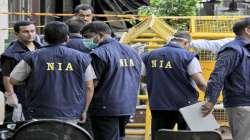IS uses Internet to radicalise, recruit sympathisers
India's leading anti-terror arm, National Investigation Agency (NIA), has found that the Internet has played a significant role in the radicalisation and recruitment of foreign fighters and it has continued to do so.

Internet is the biggest help for the Islamic State (IS) terror outfit in its quest to spread radicalisation, undertake recruitment and execute its dangerous plans across the world.
And it is through the Internet that 127 Indian youths were found to have been influenced and radicalised over the last few years.
India's leading anti-terror arm, National Investigation Agency (NIA), has found that the Internet has played a significant role in the radicalisation and recruitment of foreign fighters and it has continued to do so.
Extremist groups having allegiance with the IS, a proscribed terrorist organisation based in Iraq and Syria,reportedly "exploited the Internet as a tool and have radicalised various youth in India, UK and other countries", an intelligence official said.
Since the start of conflict in Syria in 2011, around 5,000 people from Western Europe, including 700 alone from the UK, have travelled to the war-torn country and also to Iraq to fight alongside the IS.
Over 50 people from India were also said to have gone to fight with the terror outfir in Iraq and Syria, the official told IANS requesting anonymity.
Besides, girls, as young as 15, have gone to these countries from Europe to marry IS fighters", the official added.
NIA investigations have so far revealed that IS extremists have been using the Internet as a tool since 2014 to recruit youth, aged between 16 and 26, because they were mostly attached to social networking activities.
"Extremist groups are well aware of that fact and this is why they have been constantly using social media platforms such as Facebook, Twitter and YouTube to draw youngsters to their cause," said another official on the condition of anonymity.
"Internet is being systematically exploited by the IS sympathisers. The international terrorist organisation has used the tool in a very organised way for its every terror related activity like radicalisation, training, recruitment, planning and execution."
The NIA said that it has arrested 127 IS sympathisers since 2014 in 28 cases and most of them were radicalised through social networking sites.
Majority of the arrested IS sympathisers have allegedly told their interrogators that they would listen to speeches of Islamic leaders like Zakir Naik, a Mumbai-born preacher who has fled Malaysia and wanted by Indian authorities for various crimes related to terrorism.
In three IS cases related to Tamil Nadu and Kerala, the officer said, it has come to light that the arrested persons got radicalised after listening to the audio and video messages of Zahran Hasim, the mastermind of the April 21 Easter Sunday suicide bombings in Sri Lanka this year which left over 250 dead.
The anti-terror agency said it got input about IS' presence first time in 2014 and it registered the first jihadi terrorism case related to designated terror group on November 28, 2014 naming Areeb Ejaz, Saheem, Fahad and Aman - all in the age group between 20 and 27 years.
The youths were radicalised through Internet and they left for Iraq on May 25, 2014 to join the -terror group's waged war against Asiatic Powers in alliance with the government of India and aimed to commit terrorist acts in India, the NIA said.
The youths got attracted towards the ideology of IS just a few months after its leader Abu Bakr al-Baghdadi declared the creation of a 'Caliphate' in June 2014 inside the Al Nuri mosque in Iraq's second largest city of Mosul, weeks after his fighters seized control.
Later, the NIA knew about a 29-year-old dentist Nimisha Sampath, who abruptly left India three years ago. She had gone to a dental school a few hundred miles north of her hometown in Kerala. It was there that she met her future husband. She converted to Islam from Hinduism, and he from Christianity. Authorities say they both joined the IS.
Nimisha is believed to be in Afghanistan now. She and her husband are wanted by Indian authorities, who have charged them with conspiracy and IS membership.
They are among dozens of people who have joined IS from northern Kerala in the past five years - more than anywhere else in India, according to a database of IS recruitment numbers in India compiled by the NIA.
Sri Lankan authorities probing the Easter attacks have expanded their investigation to South India, where officials say the alleged mastermind of the bombings had travelled.
It's also where one of his followers was arrested in late April, accused of planning another suicide attack. Experts believe Sri Lanka, South India and the Indian Ocean region may be a new front for global jihad.
The IS has radicalised people all over the world. Despite of having more than 180 million Muslims, India has had very few cases of radicalization.
Investigators have found that from Kasaragod in Kerala, a group of 15 people left India three years ago to join the IS in a single group.
ALSO READ| Pakistan mission supporting separatists for Kashmir unrest: NIA
ALSO READ| Kamlesh Tiwari was on ISIS hit list. Here's why